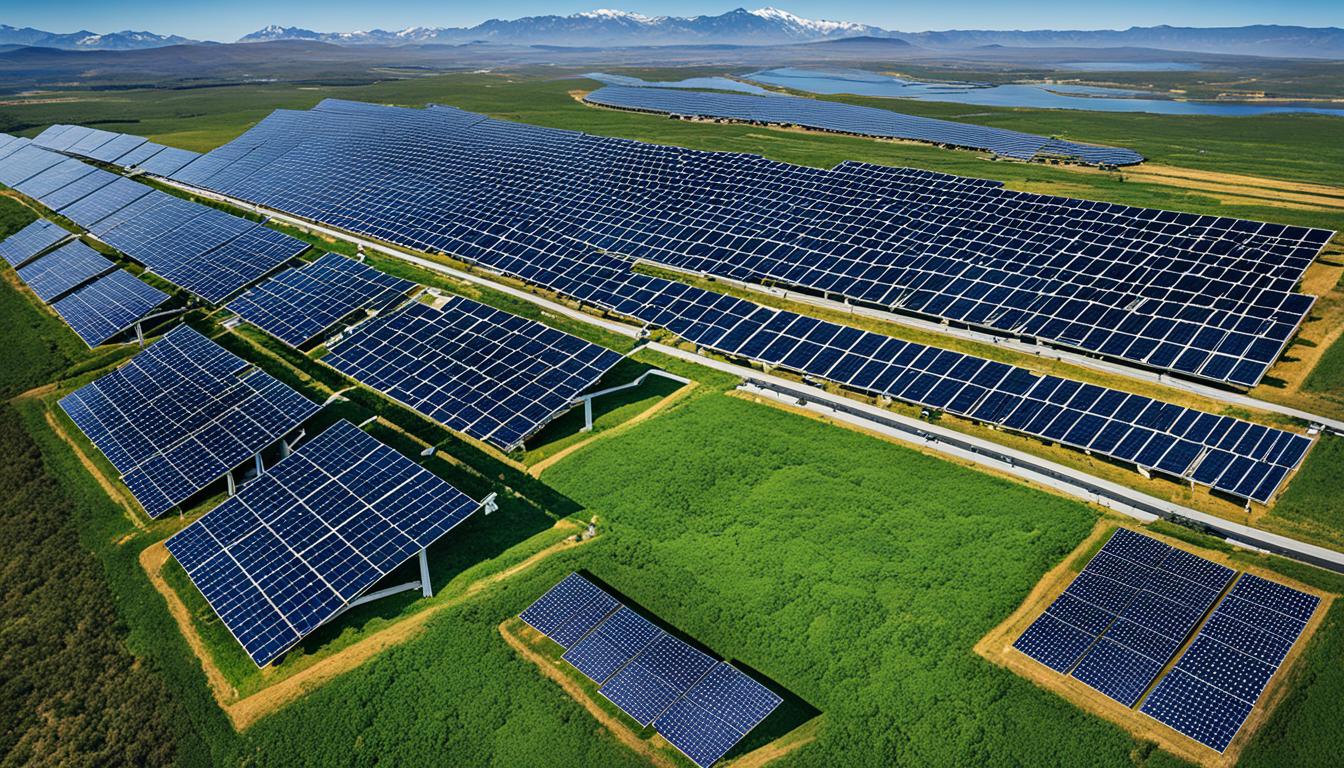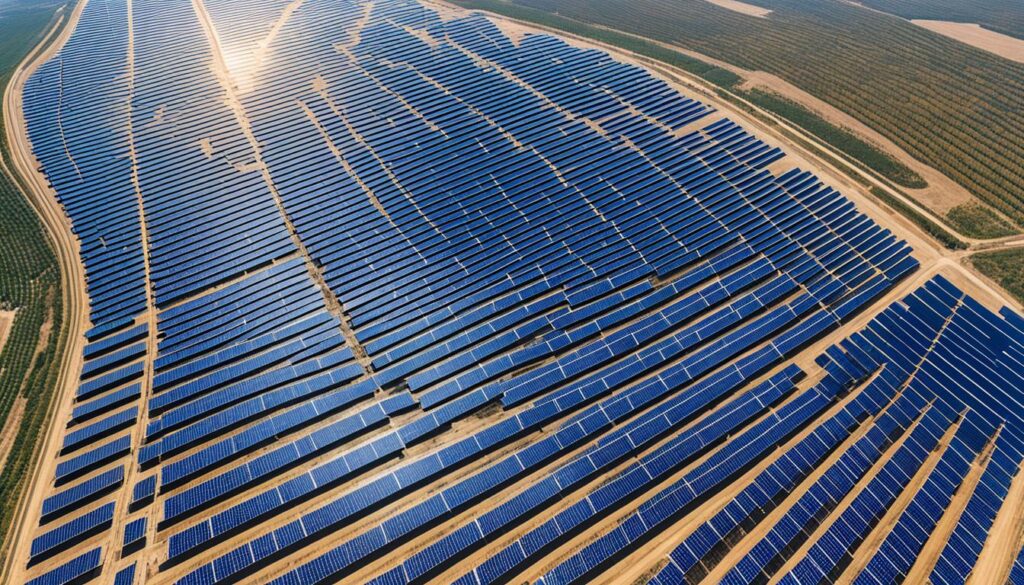
When it comes to harnessing the power of the sun, some countries are leading the way. These nations have invested significantly in solar energy infrastructure and have emerged as the frontrunners in the global solar revolution. Let’s take a closer look at the countries with the most solar power capacity and understand how they are shaping the future of renewable energy.
Key Takeaways:
- China is the global leader in solar power capacity, with over 254 gigawatts (GW) installed as of 2022.
- The United States is a major player in the solar industry, with a total installed capacity of around 99 gigawatts (GW) as of 2022.
- Other countries at the forefront of the solar revolution include India, Japan, and Germany.
- Favorable policies, incentives, and abundant sunshine have contributed to the growth of solar energy adoption in these countries.
- Solar power has the potential to pave the way for a greener and more sustainable future.
China: Leading the Global Solar Revolution
China has emerged as the global leader in solar power capacity, firmly establishing its position at the forefront of the renewable energy revolution. With an impressive installed capacity of over 254 gigawatts (GW) as of 2022, China has demonstrated its unwavering commitment to reducing greenhouse gas emissions and combatting air pollution through the widespread adoption of solar energy.
In an effort to drive the rapid growth of solar power capacity, the Chinese government has implemented a series of strategic initiatives. One key aspect of China’s approach is the provision of financial incentives and generous subsidies for both residential and commercial solar installations. This has incentivized individuals, businesses, and industries to embrace solar energy solutions, resulting in a significant increase in solar infrastructure development across the country.
China’s dedication to renewable energy extends beyond financial support. The government has also spearheaded the development of large-scale solar projects, paving the way for the integration of solar power into the national grid. These projects not only contribute to the overall solar power capacity but also ensure a reliable and sustainable energy supply for communities and industries.

The Impressive Growth of Solar Power in China
China’s investment in solar energy has yielded remarkable results, driving its rise as a global solar leader. The consistent annual growth rate of solar power capacity demonstrates the country’s dedication to the development and expansion of clean energy sources.
Let’s take a closer look at the impressive growth of China’s solar power capacity over the years:
| Year | Solar Power Capacity (GW) |
|---|---|
| 2010 | 3.4 |
| 2015 | 42.8 |
| 2020 | 253.4 |
| 2022 (as of Q3) | 254.1 |
As seen in the table above, China’s solar power capacity has experienced exponential growth, rising from 3.4 GW in 2010 to over 254 GW in 2022. This signifies a tremendous expansion and underscores China’s leadership in the global solar industry.
“China’s commitment to renewable energy and its unparalleled investment in solar power capacity have set an example for the world. The country’s dedication to combating climate change and realizing the benefits of solar energy is truly commendable.” – [Insert Expert Name], Renewable Energy Analyst
The growth of solar power capacity in China not only contributes to the global efforts in combating climate change but also provides economic opportunities. The solar industry has become a major source of employment, offering jobs in various sectors such as manufacturing, installation, and maintenance.
China’s solar revolution continues to gain momentum, with ambitious plans to further expand its solar power capacity in the coming years. The country’s commitment to a greener future sets a strong example for other nations to follow, inspiring a global shift towards clean and sustainable energy sources.
The Rise of Solar Power in the United States
The United States has emerged as a prominent player in the solar energy industry, boasting an impressive installed capacity of approximately 99 gigawatts (GW) as of 2022. This significant capacity reflects the country’s dedication to expanding renewable energy sources and reducing its carbon footprint.
Several states within the United States have taken the lead in solar power adoption, driving the nation’s solar energy revolution. With abundant sunshine and favorable policies, states like California, Texas, and Florida have paved the way for solar growth. These proactive measures have encouraged widespread adoption of solar energy systems among residential and commercial sectors, leading to a remarkable increase in solar power capacity across the country.
The federal government’s Investment Tax Credit (ITC) has played a pivotal role in propelling solar growth in the United States. This incentive offers financial benefits to owners of solar energy systems, making solar installations a financially viable option for many. The ITC has not only encouraged individuals and businesses to invest in solar power but has also contributed to the overall expansion of solar capacity in the country.
| State | Solar Power Capacity (GW) |
|---|---|
| California | 39.89 |
| Texas | 10.56 |
| Florida | 9.62 |
| New York | 7.41 |
| North Carolina | 7.28 |
Source: Data compiled from official reports by the U.S. Department of Energy.
The United States remains focused on further expanding its solar power capacity in the coming years. With ambitious goals in place, the nation aims to harness more of the sun’s energy to generate electricity and reduce its reliance on traditional, non-renewable sources. This commitment to sustainable energy will continue to drive innovation, investments, and technological advancements in the solar industry.

The Impact of Solar Power
Solar power offers numerous benefits to the United States. By harnessing the sun’s energy, the country can:
- Reduce greenhouse gas emissions to combat climate change
- Create jobs in the renewable energy sector
- Diversify the energy mix and decrease reliance on fossil fuels
- Decrease pollution and improve air quality
- Strengthen energy security and reduce dependence on imported energy sources
“Solar power has the potential to revolutionize the energy landscape in the United States. With its abundant resources and technological advancements, solar energy is transforming the way we generate electricity and paving the way for a sustainable and cleaner future.”
– Energy Expert
Conclusion
The countries leading the solar power capacity revolution include China, the United States, India, Japan, and Germany. These nations have made significant investments in solar energy infrastructure and are driving the transition to a more sustainable and clean energy future.
With the cost of solar technologies on a decline and the growing demand for renewable energy, these countries are expected to maintain their leadership positions in the solar power industry. By harnessing the power of the sun, they are not only reducing their reliance on fossil fuels but also paving the way for a greener and more sustainable world.
As the global focus on renewable energy intensifies, it is crucial for countries to continue investing in solar power capacity to meet their energy demands while mitigating climate change. The advancements made by these leading nations serve as a model for others to follow in the pursuit of a cleaner and more sustainable future.
FAQ
Which country has the highest solar power capacity?
China is the global leader in solar power capacity, with over 254 gigawatts (GW) installed as of 2022.
What has contributed to China’s leadership in solar power capacity?
China’s aggressive promotion of solar energy, efforts to reduce greenhouse gas emissions, combat air pollution, and massive investments in solar infrastructure have contributed to its leadership in solar power capacity.
What is the solar power capacity in the United States?
The United States has a total installed capacity of around 99 gigawatts (GW) as of 2022.
Which states in the United States have been leading in solar energy adoption?
States such as California, Texas, and Florida have been leading the way in solar energy adoption in the United States.
How has the federal Investment Tax Credit (ITC) influenced solar growth in the United States?
The federal Investment Tax Credit (ITC) has played a significant role in driving solar growth in the United States by providing financial benefits to solar energy system owners.
Which countries are at the forefront of the global solar revolution?
China, the United States, India, Japan, and Germany are at the forefront of the global solar revolution.
What are these leading countries doing to drive the transition towards clean energy?
These leading countries have made significant investments in solar energy infrastructure and are driving the transition towards a more sustainable and clean energy future.
What can we expect for the future of solar power in these countries?
As the cost of solar technologies continues to decline and the demand for renewable energy increases, these countries are expected to maintain their leadership positions in the solar power industry.
How is solar power contributing to a greener and more sustainable world?
By harnessing the power of the sun, these nations are paving the way for a greener and more sustainable world.








